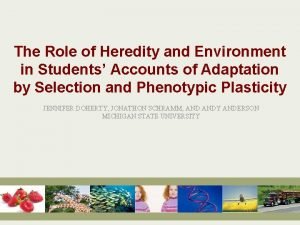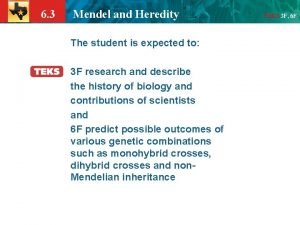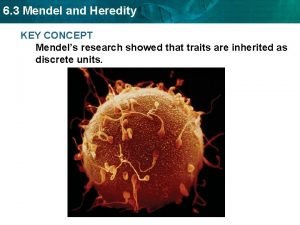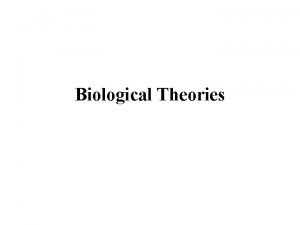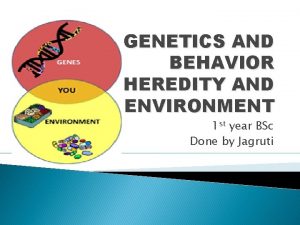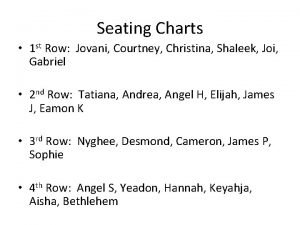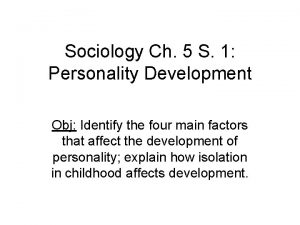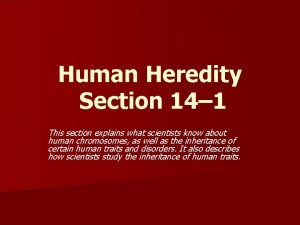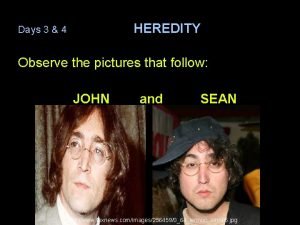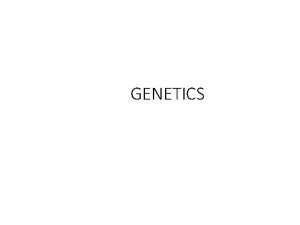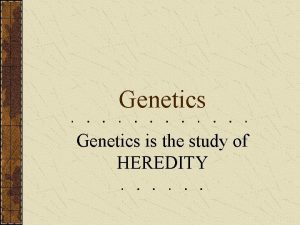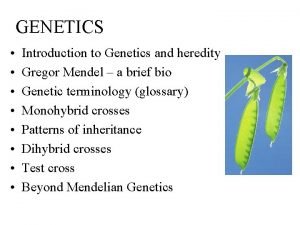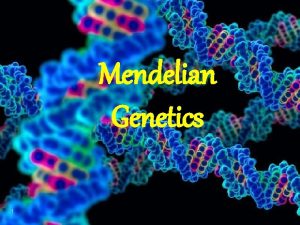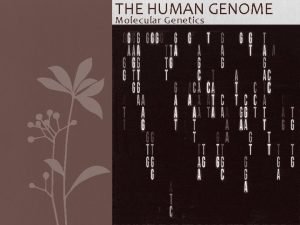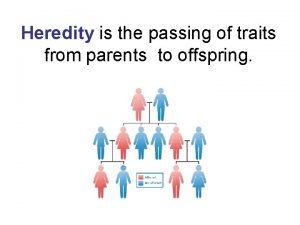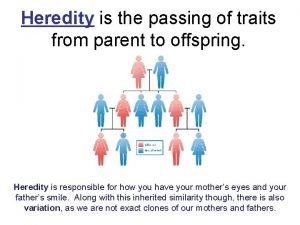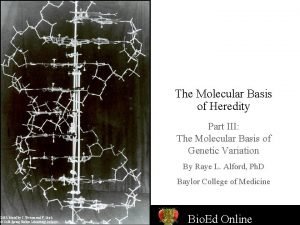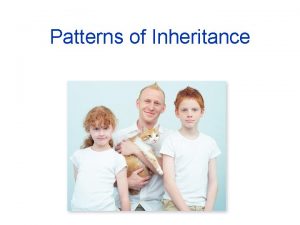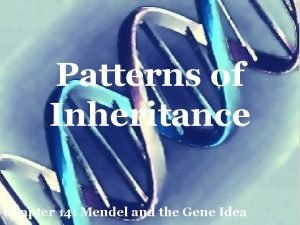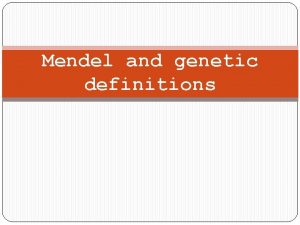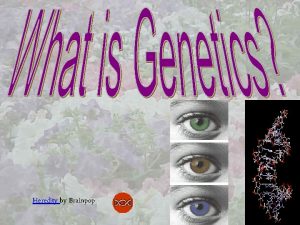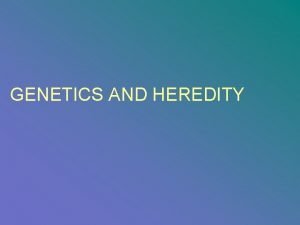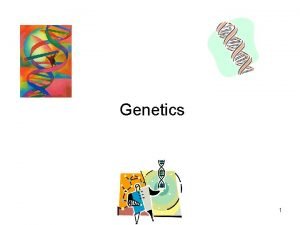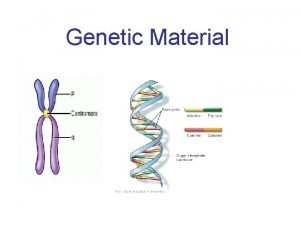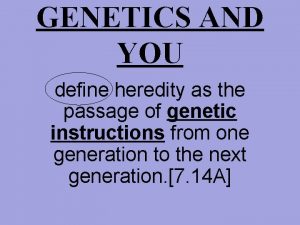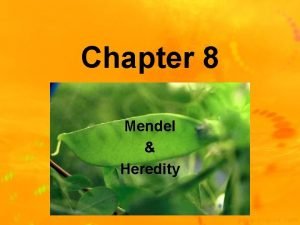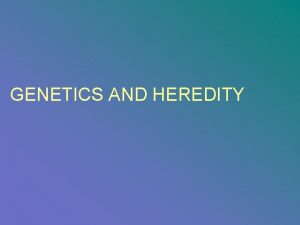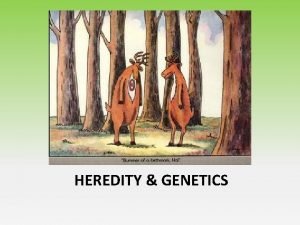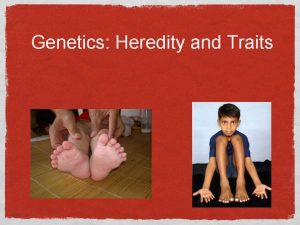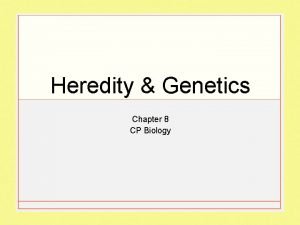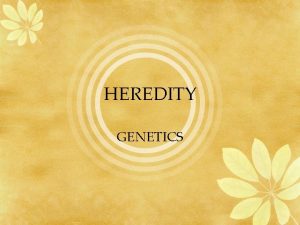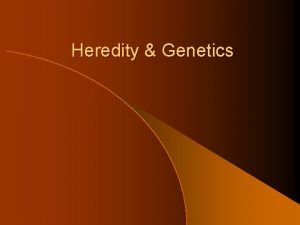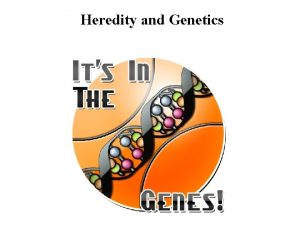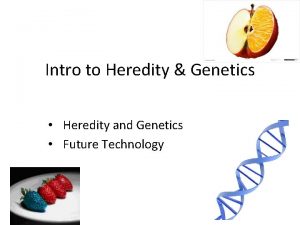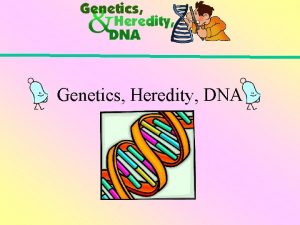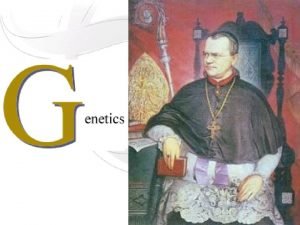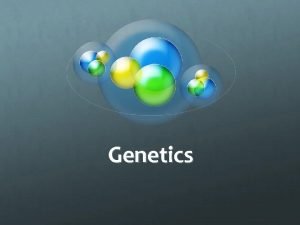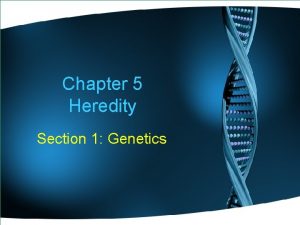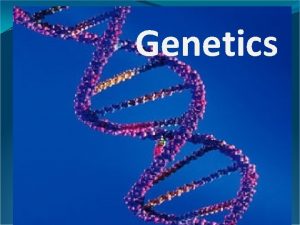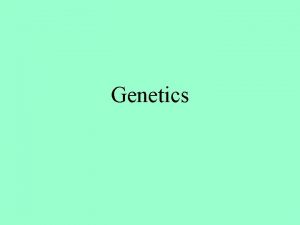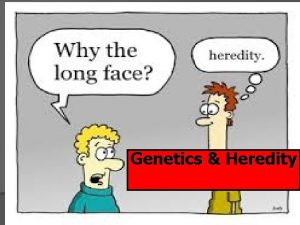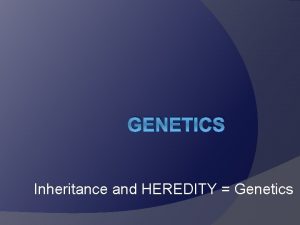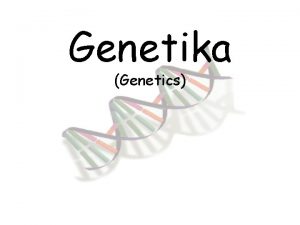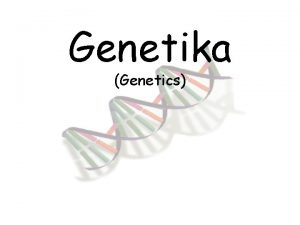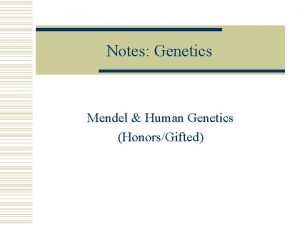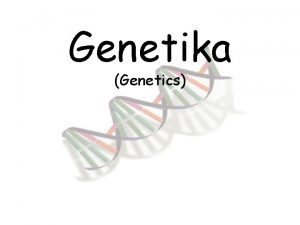Genetics And Heredity 11 1 The Work of





























































- Slides: 61

Genetics And Heredity

11. 1 The Work of Gregor Mendel Key Questions Ø Where does an organism get its unique characteristics? Ø How are different forms of a gene distributed to offspring? Vocabulary Genetics Allele Fertilization Principle of dominance Trait Segregation Hybrid gamete Gene Page 308

11. 1 The Work of Gregor Mendel The Experiments of Gregor Mendel Ø Where does an organism get its unique characteristics? An individual’s characteristics are determined by factors that are passed from one parental generation to the next. Every living thing – plant or animal, microbe or human being – has a set of characteristics inherited from its PARENT (OR PARENTS)

11. 1 The Work of Gregor Mendel Ø The delivery of characteristics from parent to offspring is called heredity. Ø The scientific study of heredity is known as genetics.

11. 1 The Work of Gregor Mendel Ø Born in 1822 in what is now the Czech Republic Ø Became a priest, studied science and math at the University of Vienna Ø Next spent 14 years at a monastery teaching high school Ø He also took care of the monastery gardens Ø He did his experiments in that garden Ø Mendel carried out his work with ordinary garden peas partly because: Ø peas are small Ø peas are easy to grow and a single pea plant can produce hundreds of offspring. Ø Peas are called a “model system” because they are convenient to study and may tell how other organisms , including humans, actually function.

11. 1 The Work of Gregor Mendel The Role of Fertilization Ø During sexual reproduction, male and female reproductive cells join in a process known as fertilization to produce a new cell.

11. 1 The Work of Gregor Mendel Ø Mendel’s garden had several stocks of pea plants. These plants were “True Breeding” (self-pollinating, produce identical offspring) Ø In other words, the traits (specific characteristics) of each generation would be the same.

11. 1 The Work of Gregor Mendel Ø To learn how these traits were determined, Mendel decided to “cross” his stock of truebreeding plants – he caused one plant to reproduce with another plant. Ø He had to prevent self-pollination, so he cut away the pollen-bearing male parts of a flower. Then he dusted the pollen from a different plant onto the female part of that flower. Ø This process, known as “cross-pollination”, allowed Mendel to breed plants with traits different from those of their parents.

11. 1 The Work of Gregor Mendel Cross Pollination 2 1

11. 1 The Work of Gregor Mendel Ø Mendel studied and crossed 7 different pea plant traits. Remember, a trait is a specific characteristic (plant height, seed color…) that varies from on individual to another. Ø Original pair of plants – P (parental generation) Ø First generation offspring (first filial) F 1 Ø Second generation offspring (second filial) F 2

11. 1 The Work of Gregor Mendel’s 7 F 1 Crosses on Pea Plants

11. 1 The Work of Gregor Mendel Some Latin… Ø Filius and filia are Latin words for “son” and “daughter” respectively. Ø The offspring of crosses between parents with different traits are called hybrids. Ø An individual’s characteristics are determined by factors that are passed from one parental generation to the next. Ø Scientists call the chemical factors that determine traits genes. Ø The different forms of a gene are called alleles. The gene for pea shape, for example, has two alleles – one for round peas and another for wrinkled peas.

11. 1 The Work of Gregor Mendel Ø What were those F 1 hybrid plants like? Did the characters of the parent plants blend in the offspring? Ø To Mendel’s surprise – NO! All of the offspring had the character of only one of the parents. In each cross, the character of the other parent seemed to disappear. Ø Mendel drew two conclusions… 1. Biological inheritance is determined by factors that are passed from one generation to the next generation. 2. The Principle of Dominance stated that some alleles are dominant and others are recessive

11. 1 The Work of Gregor Mendel Ø Your cells, like the pea plant’s cells, have two alleles for each gene – one for each chromosome of a homologous pair. The term homozygous (HOH-moh. ZY-guhs) means the two alleles of a gene are the same (for example, both alleles are for round peas) RR or rr Ø The term heterozygous (HEHT-uhr-uh-ZY-guhs) means the two alleles are different – for example, one allele is for wrinkled peas and one is for round peas) Rr Ø For Mendel’s peas, if a plant was heterozygous for pea shape, the pea shape would be round. This is because the allele for round peas is dominant or expressed when two different alleles are present.

11. 1 The Work of Gregor Mendel Ø Mendel studied traits that had just 2 alleles, one dominant and one recessive. The allele for tall plants was dominant and the allele for short plants was recessive. However, most traits involve much more complicated patterns of inheritance. Ø DOMINANT ALLELES – CAPITAL LETTERS Ø recessive alleles – lower case letters Ø A recessive allele is expressed only when there are two copies of the recessive allele. Ø A dominant allele is not better or stronger or more common; it is simply the allele that is expressed when there are 2 different alleles.

Mendel’s Pea Plants P F 1 F 2

11. 1 The Work of Gregor Mendel Segregation Ø How are different forms of a gene distributed to an offspring? During gamete formation (the sex cells), the alleles for each gene segregate from each other, so that each gamete carries only one allele for each gene. Ø Mendel’s work didn’t just stop with crossing parent plants. Where did the recessive alleles go? Did they just disappear, or were they still present in the new plants? Ø Mendel allowed all 7 kinds of F 1 hybrids to self-pollinate. (He crossed the F 1 generation with itself. ) Ø Remember that the offspring of the F 1 cross are called F 2 (second filial) generation.

11. 1 The Work of Gregor Mendel Results of F 1 Cross

11. 1 The Work of Gregor Mendel figured out that… Ø When each F 1 plant flowers and produces gametes, the two alleles segregate (separate) so that each gamete carries only a single copy of each gene. Therefore, each F 1 plant produces two types of gametes – those with the allele for tallness and those with the allele for shortness. Ø Whenever a gamete that carried the t allele paired with the other gamete that carried the t allele they produced an F 2 plant that was short. Ø Every time one or both gametes of the pairing carried the T allele, the plant was tall. Ø The F 2 generation had new combinations of allelles.

11. 1 The Work of Gregor Mendel Segregation of Alleles

11. 2 Applying Mendel’s Principles Pages 313 - 318 Key Questions Ø How can we use probability to predict traits? Ø How do alleles segregate when more than one gene is involved? Ø What did Mendel contribute to our understanding of genetics? Vocabulary Probability Phenotype Punnett square Genotype Homozygous Independent Heterozygous assortment Page 313

11. 2 Applying Mendel’s Principles Probability and Punnett Squares Probability – the likelihood that a particular event will occur Example: Flipping a coin – heads or tails. The probability that a single coin flip will come up heads is 1 chance in 2. This is 1/2, or 50%. If you flip the coin 3 times in a row, what is the probability that it will land heads up every time? ½ X ½ = 1/8 You have 1 chance in 8 of flipping heads three times in a row.

11. 2 Applying Mendel’s Principles Probability and Punnett Squares Ø Ø Ø The principles of probability can be used to predict the outcomes of genetic crosses. The gene combinations that MIGHT result from a genetic cross can be determined by drawing a diagram called a Punnett squares use mathematical probability to help predict the genotype and phenotype combinations in genetic crosses. Organisms that have 2 identical alleles for a particular trait – TT or tt are said to be homozygous. (true-breeding) Organisms that have 2 different alleles for the same trait are heterozygous (hybrid) Tt

11. 2 Applying Mendel’s Principles Probability and Punnett Squares How can we use probability to predict traits? Ø Punnett squares use mathematical probability to help predict the genotype and phenotype combinations in genetic crosses.

11. 2 Applying Mendel’s Principles Probability and Punnett Squares Punnett Square for Flower Color One Factor Cross Ratio 3: 1 One Factor Cross Bb and Bb

11. 2 Applying Mendel’s Principles Probability and Punnett Squares One Factor Cross Gg and Gg

11. 2 Applying Mendel’s Principles Independent Assortment Ø How do alleles segregate when more than one gene is involved? The principle of independent assortment states that genes for different traits can segregate independently during the formation of gametes.

Two-factor Cross (Ratio 9: 3: 3: 1) S=smooth s=wrinkled Y=yellow y=green

Two-factor Cross Pea Pod Color and Pea Color Pea Pod Color G=green g=yellow Pea Color Y=yellow y=green

11. 2 Applying Mendel’s Principles A Summary of Mendel’s Principles These Principles are… Ø Ø The inheritance of biological characteristics is determined by individual units called genes, which are passed from parents to offspring. When 2 or more forms (alleles) of the gene for a single trait exist, some alleles are dominant and some are recessive. In most sexually reproducing organisms, each adult has 2 copies of each gene – one from each parent. These genes segregate (separate) from each other when gametes are formed. Alleles for different genes usually segregate independently of each other

11. 2 Applying Mendel’s Principles A Summary of Mendel’s Principles Mendel’s experiments didn’t apply to just plants. In the early 1900’s and American geneticist, Thomas Hunt Morgan used fruit flies (Drosophila melanogaster) Fruit flies are small, can produce lots of offspring – a single pair can produce hundreds of young, and they are easy to keep in a lab

11. 2 Applying Mendel’s Principles Summary of Mendel’s Principles Thomas Hunt Morgan

11. 2 Applying Mendel’s Principles Summary of Mendel’s Principles Drosophila melanogaster (Fruit fly) Before long, Morgan and other biologists had tested Mendel’s principles and learned that they applied to flies and other organisms as well. In fact, Mendel’s basic principles can be used to study inheritance of human traits and to calculate the probability of certain traits appearing in the next generation.

11. 3 Other Patterns of Inheritance Pages 319 – 321 Key Questions Ø What are some exceptions to Mendel’s principles? Ø Does the environment have a role in how genes determine traits? Vocabulary Incomplete dominance Multiple allele Co-dominance Polygenic trait Page 319

11. 3 Other Patterns of Inheritance Incomplete Dominance Ø What are some exceptions to Mendel’s principles? Some alleles are neither dominant nor recessive. The F 1 generation produced by across between red-flower (RR) & white-flowered (WW) Plants consists of pink-colored flowers (RW). Which allele is dominant in this case? Neither one Cases where one allele is not completely dominant Over another is called incomplete dominance. This means the heterozygous phenotype lie somewhere between the two heterozygous phenotypes

11. 3 Other Patterns of Inheritance Codominance – where phenotypes produced by both alleles are clearly expressed. • Two alleles affect the phenotype in separate and distinguishable ways. • Neither allele can mask the other and both are expressed in the offspring and not in an “intermediate” form. • Example: red flowers that are crossed with white flowers that yield red and white flowers.

11. 3 Other Patterns of Inheritance Examples of Codominance White and Red flowers produce flowers with both red and white colors together Black chicken and white chicken produce a chicken speckled with black and white feathers called “erminette”.

11. 3 Other Patterns of Inheritance Multiple Alleles Ø What are some exceptions to Mendel’s principles? Ø Many genes exist in several different forms and are therefore said to have multiple alleles Ø A gene with more than two alleles is said to have multiple alleles.

11. 3 Other Patterns of Inheritance Multiple Alleles

11. 3 Other Patterns of Inheritance Polygenic Traits Ø What are some exceptions to Mendel’s principles? Many traits are produced by the interaction of several genes. o Traits controlled by two or more genes are said to be polygenic traits. o Polygenic traits often show a wide range of phenotypes. o The variety of skin color in humans comes about partly because more than four different genes probably control this trait.

11. 3 Other Patterns of Inheritance Polygenic Traits • Qualitative variation usually indicates polygenic inheritance. This occurs when there is an additive effect from two or more genes. Pigmentation in humans is controlled by at least four (4) separately inherited genes.

11. 3 Other Patterns of Inheritance Genes and the Environment Ø What are some exceptions to Mendel’s principles? Ø Environmental conditions can affect gene expression and influence genetically determined traits. Ø An individual’s actual phenotype is determined by its environment as well as its genes. Ø The phenotype of an organism is only partly determined by its genotype.

11. 3 Other Patterns of Inheritance Genes and the Environment

11. 3 Other Patterns of Inheritance Genes and the Environment In the western white butterfly, to fly effectively, the body temperature must be 28*C – 40*C (about 84*F - 104*F ). Since spring months are cooler in the west, greater pigmentation helps the butterfly reach the body temperature needed for flight (darker wings) and in the hot summer months they need less pigmentation to prevent overheating (lighter wings).

CHAPTER 14 Human Heredity 14. 1 Human Chromosomes HE. 912. C. 1. 4 Analyze how heredity and family history can impact personal health

SMALL SAMPLE OF THE VARIATION THAT EXISTS AMONG HUMANS…

14. 1 Human Chromosomes Pages 392 - 395 Key Questions Ø What is a karyotype? Ø What patterns of inheritance do human traits follow? Ø How can pedigrees be used to analyze human inheritance? Vocabulary Genome Autosome Karyotype Sex-linked gene Sex chromosome Pedigree

Ø What 14. 1 Human Chromosomes Karyotypes is a karyotype A karyotype shows the complete diploid set of chromosomes grouped together in pairs arranged in order of decreasing size. Ø The genome is the full set of genetic information that an organism carries in its DNA. The study of any genome starts with chromosomes, the bundles of DNA and protein found in the nuclei of eukaryotic cells.

14. 1 Human Chromosomes Karyotypes

14. 1 Human Chromosomes Sex chromosomes Ø Two of the 46 chromosomes in the human genome are known as sex chromosomes. ØMale – XY - 50% of sperm cells carry X chromosomes and 50% of sperm cells carry Y chromosomes ØFemale – XX - (all human eggs carry a single X chromosome

14. 1 Human Chromosomes Sex chromosomes As you can see, this is the reason why males and females are born in roughly a 50: 50 ratio.

14. 1 Human Chromosomes Autosomal Chromosomes (Autosomes) Ø Remaining 44 chromosomes are autosomes. v 44 autosomes + 2 sex chromosomes = 46 chromosomes v. To summarize the total number of chromosomes present in a human cell – both autosomes and sex chromosomes – biologists write: v 46, XX for females v 46, XY for males

Patterns of Heredity and Human Genetics Examples of Inherited Traits in Humans

Simple Dominant Traits Cleft Chin Dimples

Simple Dominant Traits Widow’s Peak Dominant Earlobe Type Free/Detached Earlobes is dominant

Simple Dominant Traits Hitchhiker’s Thumb Dominant “Straight” Thumb Recessive

Simple Dominant Traits Other Simple Dominant Traits in Humans Ø Almond-shaped eyes vs round eyes Ø Thick lips vs thin lips Ø Presence of hair on middle section of fingers Ø Brown eyes vs grey, green, hazel, blue eyes Ø Freckles vs non-freckles Ø Dark Hair vs blonde, light, or red hair Ø Non-Red Hair vs Red Hair Ø Normal Hearing and Speaking vs Deaf / Mutism Ø Normal pigmented skin vs albinism Ø Normal blood clotting vs Hemophilia

The gene for Huntington’s Disease is found on Chromosome 4.


v A neurodegenerative genetic disorder v Leads to cognitive decline & dementia v Physical symptoms usually begin between 35 and 44 years of age v Symptoms begin with gradual lack of coordination until body movement becomes jerky and uncoordinated v Mental abilities generally decline into dementia (loss of memory, thinking, speech, etc. ) v Life expectancy is around twenty years after the onset of symptoms v There is no cure for HD v Full-time care is required in the latter stages of the disease

Genetic Pedigree Chart Huntington’s Disease
 Intermediate inheritance
Intermediate inheritance Chapter 17 the beginning of the life cycle
Chapter 17 the beginning of the life cycle Section 3 mendel and heredity
Section 3 mendel and heredity Chapter 11 complex inheritance and human heredity test
Chapter 11 complex inheritance and human heredity test Unit 7 cell division and heredity
Unit 7 cell division and heredity Importance of heredity and environment in education
Importance of heredity and environment in education Section 3 mendel and heredity
Section 3 mendel and heredity Mendel 9 3 3 1
Mendel 9 3 3 1 Section 3 mendel and heredity
Section 3 mendel and heredity Section 3 mendel and heredity
Section 3 mendel and heredity Heredity and crime
Heredity and crime Heredity
Heredity Flocabulary genes and heredity answer key
Flocabulary genes and heredity answer key Genetic vocabulary worksheet answer key
Genetic vocabulary worksheet answer key Heredity characteristics include body build
Heredity characteristics include body build Mendelian genetics concept map
Mendelian genetics concept map 14-1 human heredity
14-1 human heredity Heredity is best described as the -
Heredity is best described as the - Pictures of heredity
Pictures of heredity Allele
Allele Genetics
Genetics ____________ is the study of heredity.
____________ is the study of heredity. Inheritance vs heredity
Inheritance vs heredity Chapter 11 human heredity section 11-3
Chapter 11 human heredity section 11-3 When do alleles segregate during meiosis
When do alleles segregate during meiosis What are the basic units of heredity
What are the basic units of heredity Chapter 14 human heredity
Chapter 14 human heredity Heredity torrent
Heredity torrent Heredity
Heredity Flower structure
Flower structure Heredity
Heredity 45 chromosomes
45 chromosomes Molecular basis of heredity
Molecular basis of heredity Early ideas about heredity
Early ideas about heredity Dice and coin
Dice and coin Heredity
Heredity Heredity
Heredity Character traits brainpop
Character traits brainpop Mendelian genetics vocab
Mendelian genetics vocab What is a pheontype
What is a pheontype Heredity acrostic
Heredity acrostic Heredity
Heredity Heredity is the passage of
Heredity is the passage of Heredity
Heredity Chapter 4 section 1 work and machines answer key
Chapter 4 section 1 work and machines answer key Hát kết hợp bộ gõ cơ thể
Hát kết hợp bộ gõ cơ thể Lp html
Lp html Bổ thể
Bổ thể Tỉ lệ cơ thể trẻ em
Tỉ lệ cơ thể trẻ em Gấu đi như thế nào
Gấu đi như thế nào Glasgow thang điểm
Glasgow thang điểm Hát lên người ơi alleluia
Hát lên người ơi alleluia Kể tên các môn thể thao
Kể tên các môn thể thao Thế nào là hệ số cao nhất
Thế nào là hệ số cao nhất Các châu lục và đại dương trên thế giới
Các châu lục và đại dương trên thế giới Công của trọng lực
Công của trọng lực Trời xanh đây là của chúng ta thể thơ
Trời xanh đây là của chúng ta thể thơ Mật thư anh em như thể tay chân
Mật thư anh em như thể tay chân Phép trừ bù
Phép trừ bù độ dài liên kết
độ dài liên kết Các châu lục và đại dương trên thế giới
Các châu lục và đại dương trên thế giới Thể thơ truyền thống
Thể thơ truyền thống





